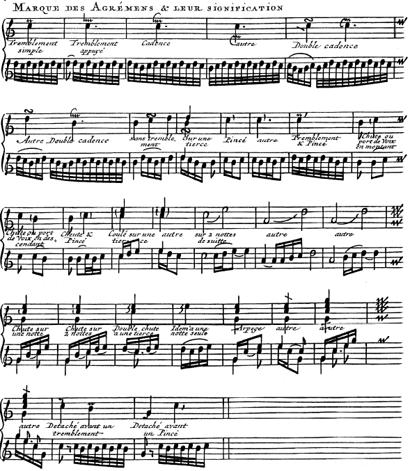Bereichsnavigation
Appendix: Tonal analysis of D’Anglebert’s sarabande

Here is a reduction, in terms of pitch-classes and keys, of the first of the two main sections (which contains three 4-bar phrases):

Further reduction:
![]()
– points to the importance of the incisively tuned G♯ in Bar 10.
The first 12 bars are repeated, and the rest of the piece consists of a 16-bar section, also repeated, plus a 4-bar coda (for a total of 12 + 12 + 16 + 16 + 4 = 60 bars, which would in turn mean a duration of three minutes if the tempo marking, »Lentement,« were taken to mean one beat per second). In following outline of the lineaments of the 16-bar section, I have adhered to the bar-numbering in the standard modern edition. It seems to me that each half of the section contains four two-bar phrases. By means of hyphens I show that within each of those phrases there is at least one (and sometimes more than one) presentation of a motif of three notes in stepwise motion. These motifs interlock in the tune in Bars 18-21 and in the bass line in Bars 16-19 and 26-27. My asterisks in regard to Bars 28-29 are to indicate an expanded version (A-F-D) of the motif, which I sense there by taking the left thumb’s F as if it were an octave higher.

The affect of majestic gravity is due partly to the uses of B♮ and C♮ and low A in the first two bars, and is well served by the fact that the first section modulates to the Dominant minor key, with only a brief intermediate reference to the relative major – the »softening« effect of which is undone by the syncopated low F in Bar 4 and by the use in Bar 5 of B♮ to imply that the relative major has been only a very transient station. In a chord-by-chord analysis (which I do not give here, since my readers can presumably make that kind of analysis on their own), the C-major triad in Bar 6 would be treated as »pivotal« since it is introduced as V of F-major and quit as VII of D-minor. The B♭'s in Bar 6 are part of a sophisticated operation of hovering throughout the first 8 bars between B♮ and B♭. B♮ wins out in the first section of the piece, but B♭ ushers in the relative major in Bars 19-20 and then points in Bar 27 to A as the 5th degree of the tonic key; and that operation is repeated in the coda.
The dramatically sotto-voce aura of Bars 14-15 is due to several factors: (1) Here is the tune of the new section starting out nearly an octave lower than where it had been at the outset of the piece, and yet (2) the bass line is less deep than ever before (and so the distance between it and the tune is now only a 5th); (3) the turns in Bar 14 are gentler than any of the preceding ornaments; (4) we have now only a three-note stepwise motif rather than the broader line of the first half; and (5) C♯ makes a more moderate- ly tempered interval in relation to A and leading-tone in relation to D than G♯ did in relation to E and A.
The second half of the second section begins (in Bar 22) with a suitably modified version of the same motivic materal as in Bar 14. The following reduction shows, however, that while the C♯ in Bar 15 is part of an arpeggiation of the A-major triad, the A in Bar 23 is related even more tellingly to the A in Bar 28 than to the F in Bar 26. This is indicated in the following reduction, in which bold font and different sizes of letters are used to indicate various levels of motivic and harmonic lineaments among the pitch classes:

One may thus discern the following structural »backbone«:

Within the limits of mood-changes feasible for a piece to which a courtly sarabande could actually be danced, there is a notable variety of affects in this piece, and in that regard the tempérament ordinaire is quite helpful not only (as already mentioned) in Bars 2 and 10 and 15 but also subsequently. In Bar 17, F♯ makes an even more moderately tempered interval in relation to D and leading-tone in relation to G than C♯ has done did in relation to A and D; an ultimate level of such warmth is attained in the majesterially unincisive leading-tones in Bars 22-24; a »normal« level of incisiveness is recovered with the C♯ in the last bar; and meanwhile the moderate but palpable dose of intonational darkness inherent in B♭ (in the tempérament ordinaire) is nicely exploited in Bars 18-22 and 25-27. These nuances don’t affect the tonal »backbone« of the piece, but beautify all the »favorite parts« (This phrase evokes implicitly a remark, which Schönberg allegedly made upon seeing an example of Schenkerian graphic analysis, to the effect that all his favorite parts of the piece had been overlooked) of its shapeliness and surface. Here is the composer’s account of how to render the ornaments:


